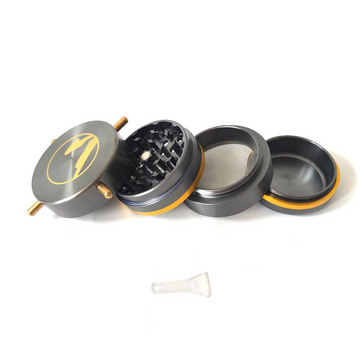How to Clean Smoking Pipes (Glass, Metal, Silicone, Wood) — Fast, Safe, and Thorough
by Sean Hu on Aug 03, 2021
A clean pipe delivers smoother hits, better flavor, and easier airflow. Resin and tar build up quickly—especially if you’re using sticky flower—so a simple maintenance routine goes a long way. This guide covers what to use, exact steps, and material-specific tips for glass, metal, silicone, and wood pipes.
Paperless, easy-clean option: try the Twisty Glass Blunt — twist to feed, twist back to save, then rinse clean.
https://twisty.shop/products/twisty-glass-blunt
What you’ll need (build your cleaning kit)
-
91%–99% isopropyl alcohol (ISO)
-
Coarse salt (Epsom/sea/kosher) – gentle abrasive for glass/metal/ceramic
-
Warm water
-
Pipe cleaners, cotton swabs, and a soft brush
-
Zip bags or small containers (for soaking parts)
-
Microfiber towel or paper towels
-
Optional: rubber stoppers/caps for sealing openings, dish soap (silicone/wood care), white vinegar (odor neutralizer)
Quick reference: what to use by material
| Material | Safe Cleaners | Avoid |
|---|---|---|
| Borosilicate Glass | ISO + salt, warm water | Boiling water, bleach/ammonia |
| Metal (stainless/aluminum) | ISO, warm soapy water | Bleach/ammonia; harsh wire brushes on threads |
| Silicone | Warm soapy water, ISO (light/short soaks), freezer-peel method | Acetone, harsh solvents, prolonged ISO soaks if finish softens |
| Wood | Dry scraping, pipe cleaners, a drop of food-safe oil on exterior | Soaking, ISO inside bowl (can strip/warp), dishwashers |
| Ceramic | ISO + salt (gentle), warm water | Sudden temp shock, harsh abrasives |
Unsure what you have? If it’s clear and sounds like glass, treat as glass. If it flexes, treat as silicone. When in doubt: warm soapy water + patience.
The universal deep-clean (glass/metal/ceramic)
-
Disassemble
Remove bowl pieces, screens, mouthpieces, stems. Empty ash. -
Warm rinse
Run warm water through the piece to loosen loose debris. -
Load cleaner
Add a spoon of coarse salt into the piece, then pour in ISO (enough to reach all inner surfaces). Put small parts into a zip bag with ISO + a pinch of salt. -
Seal & shake
Cap openings (thumbs or stoppers) and shake 60–90 seconds. The salt scrubs; ISO dissolves resin. -
Soak (optional)
For stubborn buildup, soak 15–30 minutes. Swirl occasionally. -
Detail work
Use pipe cleaners/cotton swabs to reach tight angles, carb holes, and threads. -
Rinse thoroughly
Flush with warm water until there’s zero alcohol smell. Air-dry completely before use (ISO is flammable).
Tip: A rolling tray keeps mess contained while you shake and drain.
Tray rec: https://twisty.shop/products/twisty-cowgirl-rolling-tray
Material-specific routines
Glass pipes & glass blunts
-
Follow the universal deep-clean above.
-
For Twisty Glass Blunt: remove the spiral, clean tube and spiral separately; a quick ISO wipe on the spiral, then warm rinse.
Twisty Glass Blunt: https://twisty.shop/products/twisty-glass-blunt
Metal pipes
-
ISO soak loosens resin fast.
-
Use a soft brush on threads; avoid gouging with steel wire brushes.
-
Rinse, dry fully to prevent odor carryover.
Silicone pipes
-
Warm, soapy water is usually enough.
-
Freezer-peel: place the piece in the freezer 30–60 minutes; flex to crack and peel out resin.
-
Short ISO rinses are fine for many medical-grade pieces, but avoid long soaks if you notice softening/clouding.
Wood pipes
-
Do not soak.
-
Gently scrape the bowl, run dry pipe cleaners through the stem.
-
If needed, a lightly damp swab (water) inside the stem, then dry immediately.
-
Refresh exterior with a drop of food-safe mineral oil; avoid the bowl interior.
Fast “between-sessions” refresh (1 minute)
-
Hot tap rinse (glass/metal/silicone only).
-
Quick ISO swab on the bowl rim/carb.
-
Blow through to clear moisture; set on towel to dry while you prep your herb.
Keep a tiny kit (travel ISO wipes + a couple of pipe cleaners) in your case for on-the-go cleanups.
How often should you clean?
| Usage | Water/Quick Rinse | Deep Clean |
|---|---|---|
| Heavy (daily) | After each session | Every 2–3 days |
| Moderate (few×/week) | Every session or two | Weekly |
| Occasional | Each time you notice odor/tar | Bi-weekly or monthly |
Rule of thumb: if flavor drops or draw feels tight, it’s time.
Troubleshooting
-
Lingering smell: Rinse again, then a short white vinegar rinse; final warm water rinse and full dry.
-
Cloudy interior (glass): It’s usually mineral film—use filtered water for final rinse and dry fully.
-
Clogged carb/stem: Soak longer, then push through with a pipe cleaner from both ends.
-
ISO smell after cleaning: Keep rinsing; allow complete air-dry. Never light a piece that still smells like alcohol.
Don’ts (important safety)
-
Don’t mix chemicals (e.g., bleach + ammonia).
-
Don’t boil glass (thermal shock cracks).
-
Don’t use acetone on silicone/acrylic.
-
Don’t light up until the piece is fully dry and odor-free.
Make clean sessions the default
A couple of small upgrades make maintenance painless:
-
Paperless gear = easier cleanup:
Glass blunt
Twisty Bong
Quick printable checklist
-
Disassemble → Warm rinse → ISO + salt → Shake/soak → Detail clean → Rinse → Air-dry
-
Refresh water each session (bubblers/bongs)
-
Deep clean on a schedule; don’t wait for brown water

